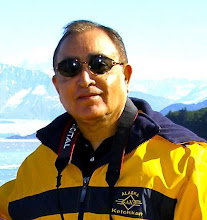String Theory: A Theory of Everything Or a Theory of Anything?
Comments by Paul Boutin on Physicist Lawrence Krauss' new book "Hiding in the Mirror"
Excerpted from Slate Online magazine (November 23, 2005)
String theory proposes a solution that reconciles relativity and quantum mechanics. To get there, it requires two radical changes in our view of the universe. The first is easy: What we've presumed are subatomic particles are actually tiny vibrating strings of energy, each 100 billion billion times smaller than the protons at the nucleus of an atom.
That's easy to accept. But for the math to work, there also must be more physical dimensions to reality than the three of space and one of time that we can perceive. The most popular string models require 10 or 11 dimensions. What we perceive as solid matter is mathematically explainable as the three-dimensional manifestation of "strings" of elementary particles vibrating and dancing through multiple dimensions of reality, like shadows on a wall. In theory, these extra dimensions surround us and contain myriad parallel universes. Nova's "The Elegant Universe" used Matrix-like computer animation to convincingly visualize these hidden dimensions.
Sounds neat, huh—almost too neat? Krauss' book is subtitled The Mysterious Allure of Extra Dimensions as a polite way of saying String Theory Is for Suckers. String theory, he explains, has a catch: Unlike relativity and quantum mechanics, it can't be tested. That is, no one has been able to devise a feasible experiment for which string theory predicts measurable results any different from what the current wisdom already says would happen. Scientific Method 101 says that if you can't run a test that might disprove your theory, you can't claim it as fact. When I asked physicists like Nobel Prize-winner Frank Wilczek and string theory superstar Edward Witten for ideas about how to prove string theory, they typically began with scenarios like, "Let's say we had a particle accelerator the size of the Milky Way …" Wilczek said strings aren't a theory, but rather a search for a theory. Witten bluntly added, "We don't yet understand the core idea."
If stringers admit that they're only theorizing about a theory, why is Krauss going after them? He dances around the topic until the final page of his book, when he finally admits, "Perhaps I am oversensitive on this subject … " Then he slips into passive-voice scientist-speak. But here's what he's trying to say: No matter how elegant a theory is, it's a baloney sandwich until it survives real-world testing.
Krauss should know. He spent the 1980s proposing formulas that worked on a chalkboard but not in the lab. He finally made his name in the '90s when astronomers' observations confirmed his seemingly outlandish theory that most of the energy in the universe resides in empty space. Now Krauss' field of theoretical physics is overrun with theorists freed from the shackles of experimental proof. The string theorists blithely create mathematical models positing that the universe we observe is just one of an infinite number of possible universes that coexist in dimensions we can't perceive. And there's no way to prove them wrong in our lifetime. That's not a Theory of Everything, it's a Theory of Anything, sold with whizzy PBS special effects.


0 Comments:
Post a Comment
<< Home